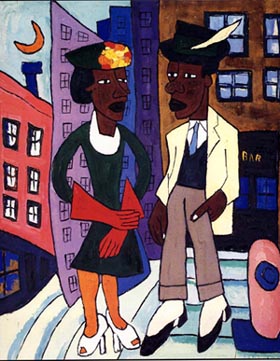| ONLINE JOURNAL |
| "Cafe" by Wiilliam H. Johnson from Harlem Renaissance Art |
e-texts of essays and poems
1. "The Negro Artist and the Racial Mountain"
2. "The
Negro Speaks of Rivers"![]()
--some questions for
discussion ![]()
--brief analysis of
the poem ![]()
--interpretation of
the poem ![]()
--Another interpretation
of the poem ![]()
3. "The South"
5. "When Sue Wears Red" and other Hughes' poems
6. "Jazzonia" together with cover of the dust jacket for Hughes' first book The Weary Blues:
8. "Mulatto"
9. "Spirituals"
12. "Dream Boogie"
13. "Harlem [2]"
--See our English
Literature Databank ![]()
--video clip of
the poem ![]()
![]()
--student essay
about the poem ![]()
| 1. The Weary Blues | the song |
| 2. Suicide | the song |
| 3. Bad Man | the song |
| 4. Po' Boy Blues | the song |
| 5. Homesick Blues | the song |
| 6. Gal's Cry For a Dying Lover | the song |
| 7. Listen Here Blues | the song |
| 8. Ma Man | the song |
| 9. Out of Work | the song |
| 10. Evenin' Air Blues | the song |
| 11. Red Clay Blues (co-written with Richard Wright) | the song |
| 12. Six Bits Blues | the song |
| 13. The Backlash Blues | the song |
Langston Hughes was one of the writers
and artists who helped to revitalize African-American art
and literature
in the 1920s. That group of artists and writers
promoted the resurgence of interest
and enthusiasm
for African-American art in what is now called
the Harlem Renaissance.
| 1. For
a good introduction to the Harlem Renaissance. (This site also features links to various writers from the Harlem Renaissance and a link which lets you listen to some music from that period. That music might help you understand the poem "Jazzonia.") 2. General introduction to some poets of the Harlem
Renaissance 3. The e-text and an introduction to a 1925 issue
of a journal called
4. An online exhibition about the community of
Harlem from
5. Another good site introducing the artists and
writers of the
|

"Street Life -- Harlem" (ca. 1939-40) by William H. Johnson, from William H. Johnson's Gallery |
1. An interesting statement by a student
explaining why Langston Hughes is his favorite poet ![]()
2. online student responses to several of
the poems we are reading, including "The Negro Speaks of Rivers"
and "Harlem" ![]()
3. A review of The Collected Poems of
Langston Hughes that discusses important issues and
themes in Hughes' poetry ![]()
4. link to The Langston Hughes Review![]()
5. online audio recording of four stories
by Hughes about the character Simple ![]()
![]()
***The background picture is "Lenox
Avenue" by Sargent Johnson. It is taken from Harlem
Renaissance Art.
 |
 |